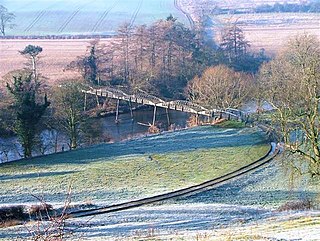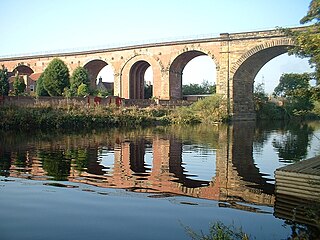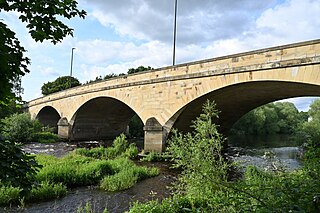
The River Tees, in England, rises on the eastern slope of Cross Fell in the North Pennines and flows eastwards for 85 miles (137 km) to reach the North Sea in the North East of England. The modern-day history of the river has been tied with the industries on Teesside in its lower reaches, where it has provided the means of import and export of goods to and from the North East England. The need for water further downstream also meant that reservoirs were built in the extreme upper reaches, such as Cow Green.

Yarm, also referred to as Yarm-on-Tees, is a market town and civil parish in the Borough of Stockton-on-Tees, North Yorkshire, England. It is on a small meander of the River Tees. To the south-east, it extends to the River Leven, to the south it extends into the Kirklevington.

Sockburn is a village and former civil parish, now in the parish of Neasham, in the Darlington district, in the ceremonial county of Durham, England. It is situated at the apex of a meander of the River Tees, to the south of Darlington, known locally as the Sockburn Peninsula. Today, all that remains of the village is an early nineteenth-century mansion, a ruined church and a farmhouse built in the late eighteenth century.

Winston is a village and civil parish in County Durham, England. It is situated approximately 6 miles (9.7 km) east of Barnard Castle, on a crossroads between the A67 and B6274 roads. According to the 2011 UK Census the population was 431, the parish includes the hamlets of Little Newsham and South Cleatlam.

Hurworth Place is a village in County Durham, in England. It lies south of Darlington on the northern bank of the River Tees, opposite the village of Croft-on-Tees in North Yorkshire to which it is linked by Croft Bridge, a Grade I listed structure dating from the 14th century, which marks the county boundary. It is part of the civil parish of Hurworth.

Hurworth-on-Tees is a village in the borough of Darlington, within the ceremonial county of County Durham, England. It is situated in the civil parish of Hurworth. The village lies to the south of Darlington on the River Tees, close to its meeting point with the River Skerne, and immediately adjoins the village of Hurworth Place, which forms part of the same civil parish.

Dalton-on-Tees is a village and civil parish in North Yorkshire, England, near the boundary with County Durham. According to the 2001 Census there were 318 people living in the parish in 120 houses. The population had decreased to 303 by the time of the 2011 Census.

Croft-on-Tees is a village and civil parish in North Yorkshire, England. It has also been known as Croft Spa, and from which the former Croft Spa railway station took its name. It lies 11 miles (18 km) north-north west of the county town of Northallerton.

Appersett is a hamlet in the Yorkshire Dales in the Richmondshire district of North Yorkshire, England one mile (1.6 km) west of Hawes. It lies on the A684 road and an unclassified road runs alongside Widdale Beck to connect with the B6255 road between Hawes and Ingleton.

Girsby is a village and civil parish in the former Hambleton District of North Yorkshire, England. The village lies on high ground on the eastern bank of the River Tees. The population of the parish was estimated at 40 in 2015. The population as of the 2011 census remained less than 100. Details are included in the civil parish of Over Dinsdale.
In the folklore of Northumbria, the Sockburn Worm was a ferocious wyvern that laid waste to the village of Sockburn in Durham. It was said that the beast was finally slain by John Conyers. The tale is said to be the inspiration for Lewis Carroll's poem Jabberwocky which he wrote while in Croft-on-Tees and Whitburn.

Croft Spa railway station was a railway station serving the settlements of Croft-on-Tees and Hurworth-on-Tees in County Durham, England.
The A1 road around Gateshead and Newcastle upon Tyne after arriving from the south as the A1(M) from its origin in London, currently runs from the A1(M) terminus at Birtley. It then swings to the west of both Gateshead and Newcastle via Coal House, Lobley Hill, Metrocentre, Swalwell, Blaydon Bridge, West Denton, Fawdon and Wideopen to Seaton Burn interchange before continuing north towards Edinburgh.

The Church of St Peter, Croft-on-Tees is a 12th century grade I listed parish church in the village of Croft-on-Tees in North Yorkshire, England. Artefacts and carvings inside the church are believed to have given rise to many of the characters created by Lewis Carroll, who as a child, attended St Peter's in the 1840s when his father was rector of the church.

Yarm Viaduct is a railway viaduct carrying the railways above the town of Yarm in North Yorkshire, England. It crosses the River Tees which forms the boundary between North Yorkshire and County Durham. The railway runs between Northallerton and Eaglescliffe, and was opened in 1852 as part of the extension of the Leeds Northern Railway to Stockton-on-Tees. The line and viaduct are currently owned and maintained by Network Rail and carries passenger traffic for TransPennine Express and Grand Central train operating companies. It also sees a variety of freight traffic.

Blackwell Bridge is a masonry road bridge spanning the River Tees between County Durham and North Yorkshire, in Northern England. The bridge was built in 1832, and widened in 1961. It carries the A66 road, which stems from the A66(M) spur off the A1(M) motorway. It used to be the main route north on the A1 until a bypass was opened in 1965.

Croft Viaduct is a railway bridge carrying the East Coast Main Line between Northallerton and Darlington in Northern England. The viaduct crosses the River Tees, the border between North Yorkshire and County Durham. Although it was an early example of a stone viaduct in the railway system, it is not the first true railway viaduct, however, it was the first railway viaduct in the United Kingdom to have been built with an oblique arch. It was grade II listed in 1988, and had overhead line equipment installed in the early 1990s.

Mercury Bridge, is a grade II listed structure that crosses the River Swale in North Yorkshire, connecting the town of Richmond to the south side of the river. The bridge was commissioned by the railway company whose Richmond railway station terminus lay across the river, and so provided ease of access to Richmond town where there had not been a bridge before. The bridge now carries the A6136 road and was renamed from Station Bridge in 1975 in honour of the Royal Corps of Signals. The bridge was noted for being one of a few railway-owned bridges which carried no rails.

Green Bridge is a road bridge crossing the River Swale in Richmond, North Yorkshire, England. Until the building of Mercury Bridge adjacent to the railway station in 1846, it was the only crossing over the River Swale from Richmond. Historically, the bridge carried the Richmond to Lancaster Turnpike, and is now a grade II* listed structure.


















